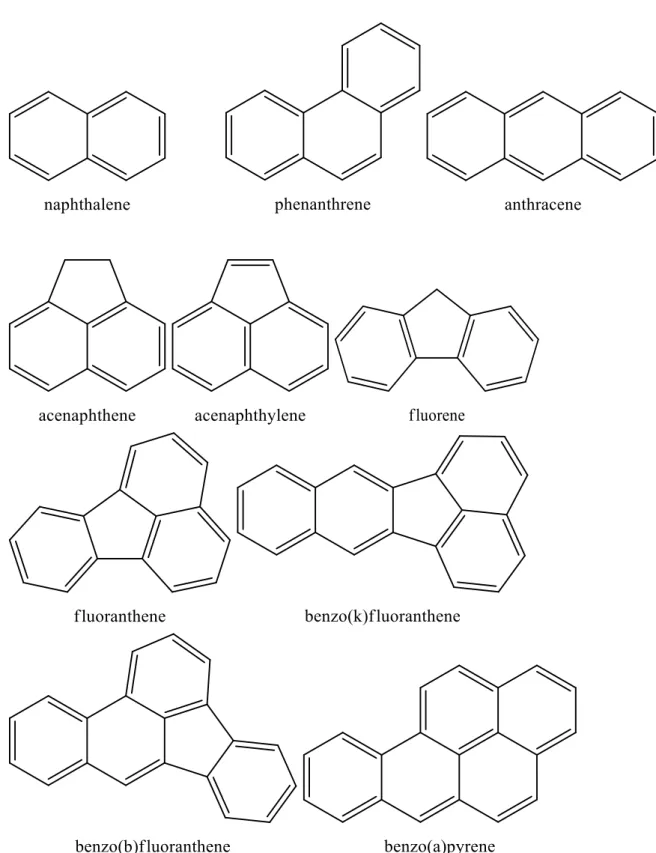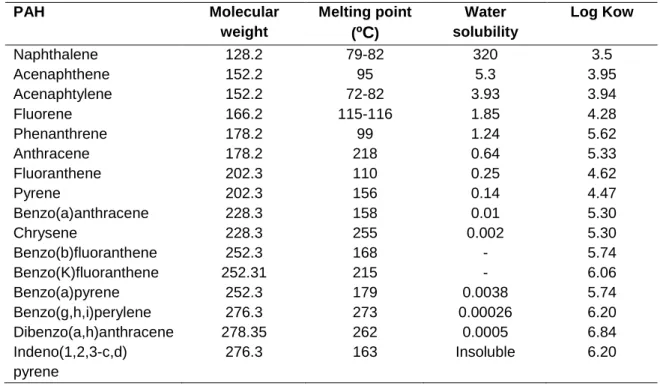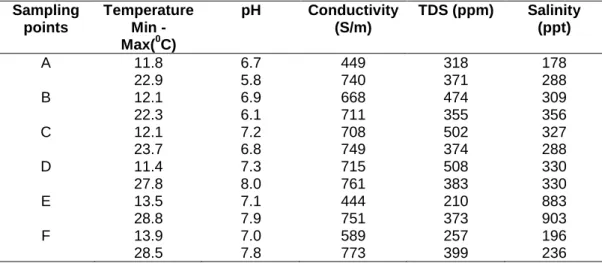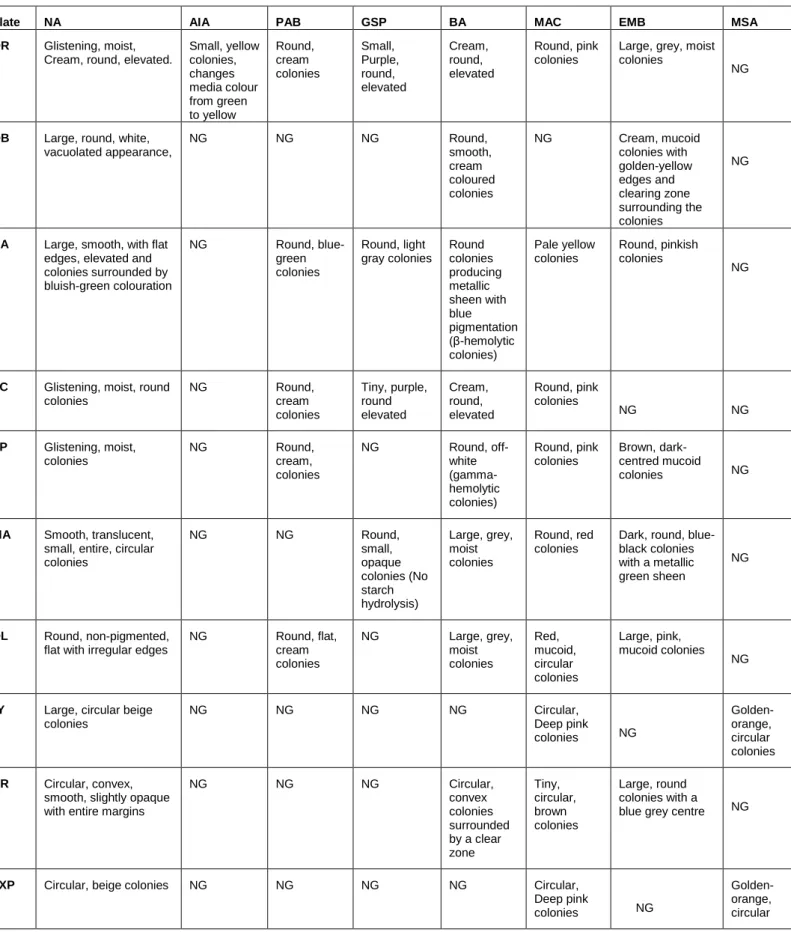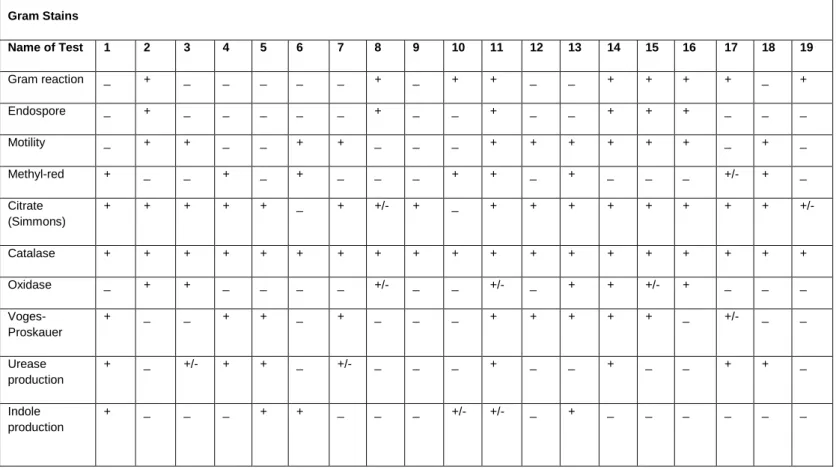7 Figure 2: Map of the rivers Diep and Plankenburg with locations of sampling locations (agricultural and residential area, substation in industrial area, informal settlement of Kayamandi, nature reserve Zoarvlei, sports club Theo Marias and rowing club Rietvlei). 44-45 Table 5: Phenotypic characterization of the bacterial isolates obtained from the Diep- and Plankenburg river systems.
INTRODUCTION
- Background
- Introduction
- Research objectives
- Significance of the research
- Delineation of the research
This study aimed to isolate and identify four potential PAH-degrading microorganisms from the Diep and Plankenburg rivers in the Western Cape, South Africa, as well as to determine their degrading potential of two PAHs (acenaphthene and fluorene) under optimum temperature conditions investigation. The study instead focused on temperature optimization and the ability of the bacterial species to utilize the compounds as nutritional sources.
LITERATURE REVIEW
Water
Environmental pollution
Water pollution
Persistent Organic Pollutants (POPs)
Properties of Polycyclic Aromatic Hydrocarbons
Sources and Occurrence of PAHs
Keynote: Log Kow: Octanol-water partition coefficient. wear of tires and asphalt components) (Kamaljit et al., 2010). Vegetation in urban areas, especially those close to roads and industries, have been reported to have higher doses of PAHs (Gomes et al., 2013).
Effects of PAHs
Many studies have investigated the effects of PAHs on aquatic organisms (Varanasi et al., 1989; Harvey, 1997). A study by Martineau et al. 2002) in the St Lawrence Estuary, Quebec (Canada) on SLE Beluga (Delphinapterus leucas).
Persistence of PAHs in the environment
Smelting aluminum can lead to PAH contamination because the reductant used in the process is usually a source of carbon, such as coke or charcoal (Habashi, 2003). The occurrence of PAHs with co-pollutants such as hydrocarbons, phenols, BTEX compounds and heavy metals is another factor that can extend their residence time in the environment (Bamforth and Singleton, 2005).
Bioavailability of PAHs for microbial degradation
The stimulatory effect of surfactants was found to be solely due to the increased bioavailability of PAHs, indicating that the oxidation of PAHs by the extracellular ligninolytic enzymes is limited by low bioavailability of the compound (Lu et al., 2006 ). Many other researchers have also reported the effect of hydrodynamics on the mass transfer rate of PAH particles (Vinas et al., 2005; Singh, 2006).
PAH remediation
This technique is very expensive and carries similar benefits and limitations to dredging, in addition to the technical challenge of maintaining "dry" conditions (Reible et al., 2006). Uncontrolled low-temperature thermal treatment of organic waste can lead to the formation of PAHs with more than four rings, while degradation only occurs for PAHs with less than four rings (Pakpahan et al., 2009).
Demerits of conventional PAH remediation techniques
Bioremediation (Biological Treatment of contaminants)
Bioaugmentation
Biostimulation
Phytoremediation
Research has shown that several grasses and legumes are potential candidates for phytodegradation of organic crops (Ukiwe et al., 2013). It was reported that industrial hemp (Cannabis sativa) degrades B(a)P and that chrysene, ryegrass (Lolium multiflorum) and water hyacinth (Eichhornia crassipes) reduce about 45% naphthalene in waste water in seven days (Ukiwe et al ., 2013) and Bermuda grass (Cynodon dactylon) reported to degrade naphthalene.
Bioremediation of PAHs
PAHs commonly contaminate anaerobic environments such as aquifers (Bakermans et al., 2002) and marine sediments (Coates et al., 1997). Alternatively, some anaerobic microorganisms can break down organic contaminants through fermentation, with the organic contaminants acting as electron acceptors (Gan et al., 2009; Ukiwe et al., 2013).
Factors affecting bioremediation of PAHs
These dihydrodiols are dehydrogenated to form dihydroxylated intermediates that can be further metabolized via dihydroxy compounds (catechols) to carbon dioxide and water (Habe and Omori, 2003; Wick et al., 2011). White trochnoea fungi produce extracellular lignin-degrading enzymes with low substrate specificity, making them ideal PAH degraders under aerobic conditions (Gan et al., 2009). Unlike aerobic biodegradation, anaerobic microorganisms use other available substances such as nitrate, sulfate, iron, manganese, and carbon dioxide as their electron acceptors to break down organic compounds into smaller components, often producing carbon dioxide and methane as end products (Gan et al., 2009).
However, fungi are known to be more tolerant to acidic conditions (Al-Daher et al., 1998). Degradation of hydrocarbons has previously been reported both at near-freezing temperatures and above 30ºC (Kostka et al., 2011). A study by Minai et al. 2012) showed that PAH degradation was more efficient in a medium containing 0% NaCl than in a 5% NaCl medium.
Biosurfactants
The study showed that this strain could degrade 93.92% of phenanthrene and is able to degrade other PAHs such as anthracene and fluorine. Other microorganisms such as Bacillus subtilis, Pseudomonas aeruginosa and Torulopsis bombicola have been reported to produce surfactants such as surfactin, rhamnolipid and sophorolipid capable of enhancing PAH bioremediation (Kuyukina et al., 2005; Cottin and Merlin, 2007).
Bacterial degradation of PAHs
Pseudomonas, Agrobacterium, Bacillus, Burkholderia, Sphingomonas, Rhodococcus, Mycobacterium as well as mixed cultures of Pseudomonas and Flavobacterium species have all been reported to degrade B(a)P efficiently (Bhatnagar and Kumari, 2013). Bacillus firmus has been reported to completely degrade benzo(b)fluoranthene, dibenzo(a,h)anthracene and indeno (1,2,3-c,d)pyrene (Bayoumi, 2009).
Fungal degradation of PAHs
Algal degradation of PAHs
Genetically Engineered Microorganisms
Bioreactors
Biofilms
Diep River
Plankenburg River
MATERIALS AND METHODS
- Sampling Site Identification
- Sampling
- Determination of the presence and concentration of acenaphthene and fluorene in the River
- Isolation and Identification of bacterial species from the Diep- and Plankenburg River
- Molecular Identification of bacterial isolates obtained from Diep- and Plankenburg Rivers
- Identification of potential PAH-degrading bacterial species using temperature optimisation
- Degradation study
- Data Analysis
Determination of presence and concentration of acenaphthene and fluorine in river systems fluorine in river systems. Each of the dried concentrates was dissolved in 1 ml of n-hexane and filtered through 0.45 μm Millipore acrodisc membrane filters (Olatunji et al., 2014). MR-VP broth was inoculated with pure cultures of the test organisms (use of heavy inoculum was avoided).
To generate phylogenetic relationships (trees), the nucleotide sequences of the isolated species were aligned with Mafft version 7. Cultivation was performed by taking 1 ml of the sample as soon as possible, serially diluting tenfold and then plating on media plates. The degradation potential of the identified isolates was determined using HPLC coupled with a dual wavelength absorbance detector (Dodor et al., 2004).
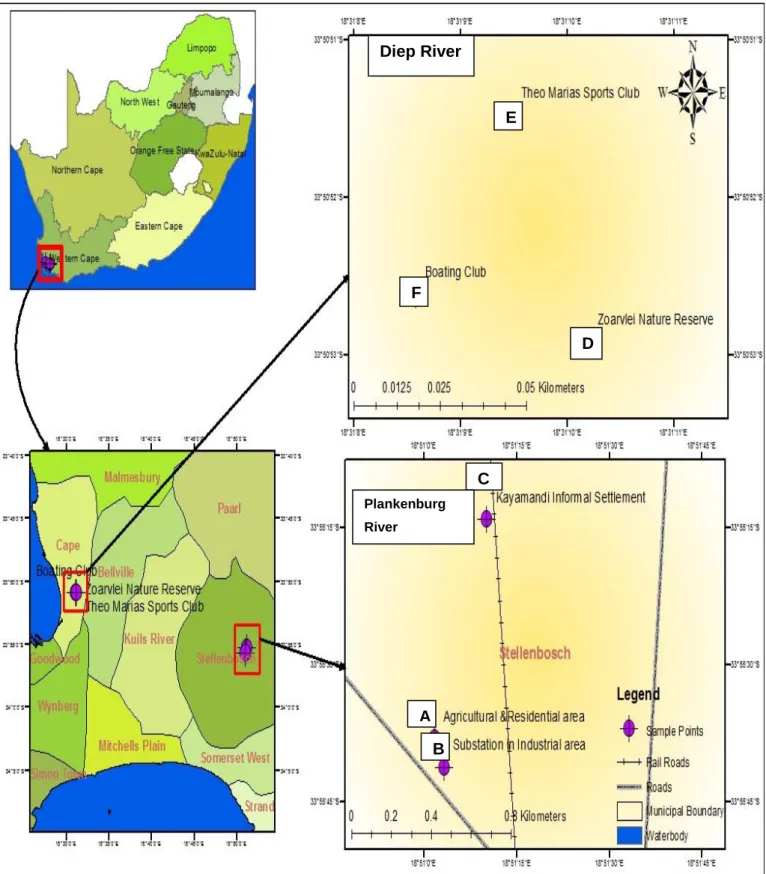
RESULTS AND DISCUSSION
Physicochemical parameters and microbial numbers
The dense vegetation on the riverbanks at this site could possibly also contribute to slower water flow, thereby encouraging microbial growth and increased numbers (Fischer et al., 2003). Various representatives of Enterobacteriaceae such as Raoultella, Serratia, Klebsiella, Citrobacter and Enterobacter were detected at all sampling sites along the Plankenburg River. This corresponds to the results of Paulse et al. 2009) who studied microbial contamination along the Plankenburg River and found high levels of faecal contamination at these locations.
The highest microbial load (2.12 x 108 CFU/ml) was recorded at site F (Rietvlei boating club) while the highest microbial activity was recorded at site E (Theo Marias sports club (Figs 3 and 4). These were the highest salinity values recorded from sampling points along the studied river systems, but the occurrence of these halo-tolerant microorganisms may also be due to inputs from the lagoon and ocean being only a few kilometers from this location (Haskins, 2014). substances, A - agricultural farming and residential area, B - substation in industrial area, C - informal settlement of Kayamandi (on the Plankenburg River).
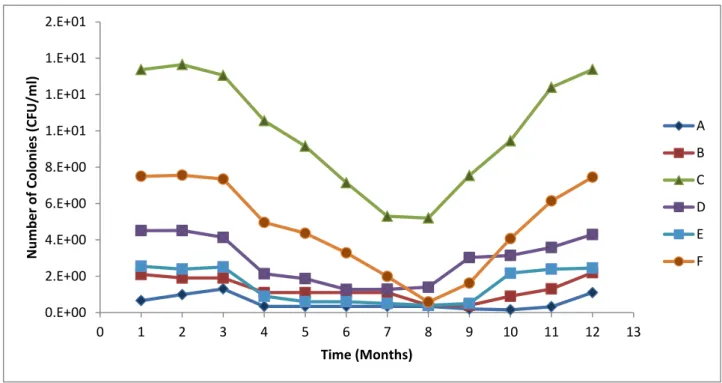
PAHs in the River systems
Canadian Soil Quality Guidelines: Carcinogens and Other Polycyclic Aromatic Hydrocarbons (PAHs) (Effects on the Environment and Human Health). Effects of polycyclic aromatic hydrocarbons (PAHs) on an aquatic ecosystem: acute toxicity and community-level toxic effect testing of benzo(a)pyrene using the lake zooplankton community. Bioremediation of high molecular weight polycyclic aromatic hydrocarbons: an overview of the microbial degradation of benzo(a)pyrene.
Determination of polycyclic aromatic hydrocarbons (PAHs) in water and sediments of the Kor River, Iran. American Society for Microbiology (ASM Microbe Library) p. 1-3. Bioaccumulation of polycyclic aromatic hydrocarbons in marine organisms. Effect of salinity on the biodegradation of heavy crude oil polycyclic aromatic hydrocarbons (PAHs) in soil.
Determination of Polycyclic Aromatic Hydrocarbons (PAHs) in river water samples from the Vaal Triangle area in South Africa. Advice of the Scientific Committee on Food on the risks to human health of Polycyclic Aromatic Hydrocarbons in food.
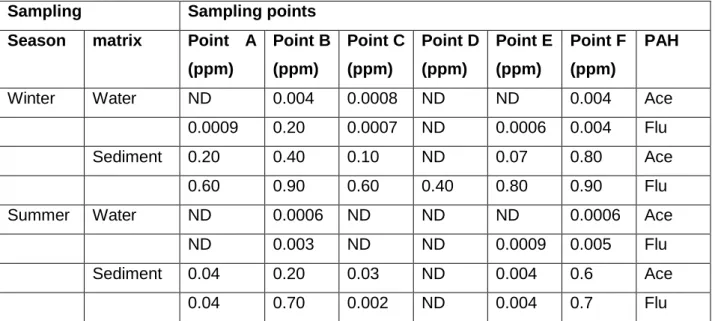
Bacterial isolates identified from the Diep- and Plankenburg River systems using conventional
Molecular Identification of bacterial isolates obtained from Diep- and Plankenburg Rivers
The BLAST identification results shown in Table 6 were obtained from the DNA sequences queried in the NCBI database. The position where Citrobacter freundii is placed on the tree is not entirely consistent with classical taxonomy, but similar results were obtained by Dauga (2002), who also reported conflicting evolutionary relationships for Citrobacter freundii. The study compared phylogenetic relationships generated from gyrB and 16S rRNA sequences and concluded that trees based on gyrB are more reliable in determining relationships than trees based on 16S rRNA.
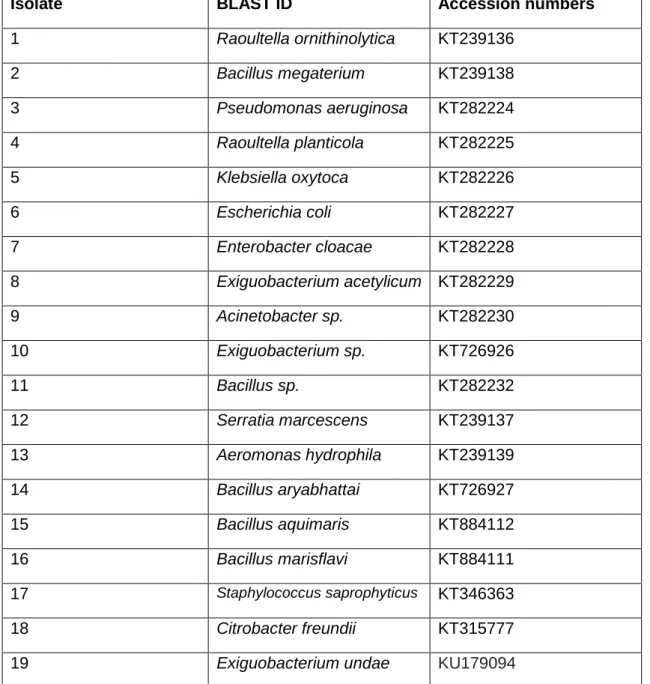
Identification of potential PAH-degrading bacterial species using temperature optimisation
Degradation efficiencies
For Raoultella ornithinolytica and Serratia marcescens on acenaphthene and fluorene respectively, the most efficient degradation was observed at 37ºC with an average percentage degradation of 97.80% and 99.90% achieved by R. For Aeromonas hydrophila, optimum degradation was observed with a percentage of 35ºC. 99.50% and 99.10% achieved for acenaptene and fluorene respectively. The results obtained showed that for the pure strain experiments, Aeromonas hydrophila degraded acenaphthene most efficiently at 99.50%, while Raoultella ornithinolytica degraded fluorene most efficiently at 99.90%.
On the stirred tank Bioreactor scale, the average percentage of degradation achieved ranged between 90.20% and 99.90% for all experiments (Table 9).
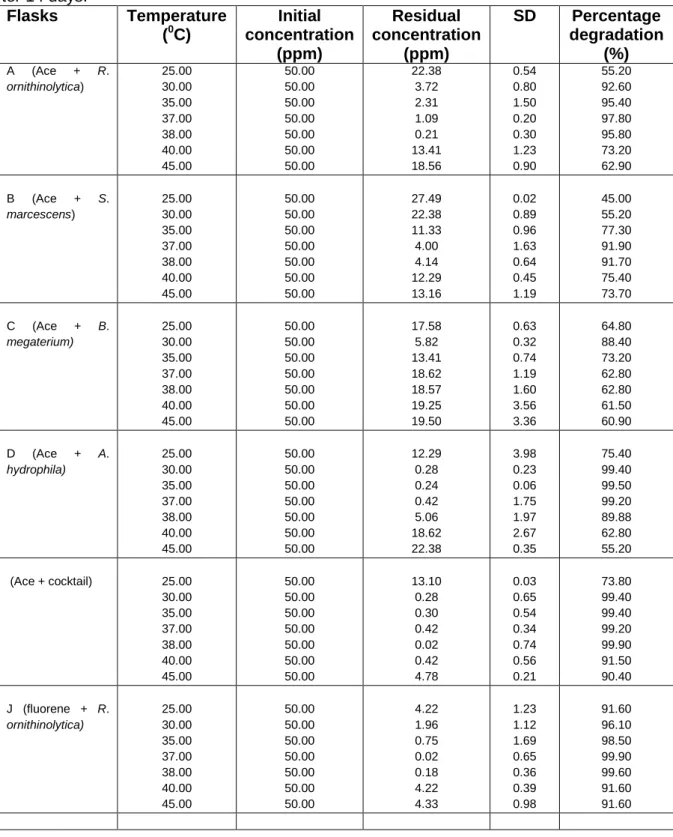
Microbial Cell Count during and after degradation
There was an increase in mean plaque count ranging from 4x105 CFU/ml to 6x108 CFU/ml after seven days for S. In the Stirred Tank Bioreactor scale, an increase in plaque count ranging from 4x104 CFU/ml to 5x106 CFU/ml to 8x109 CFU/ml to 9x109 CFU/ml by the seventh day for all experiments (Fig. 14), this trend is comparable to the results obtained by Moscoso et al. The reason for the increased number of plaques is explained by Moscoso et al. 2012), whose study found that an increase in the number of plaques is associated with rapid cell proliferation.
The study revealed that the increase in plaque count during biodegradation is due to rapid proliferation of cells due to the provision of sufficient carbon sources. However, by the end of the experiments there was either a drastic decrease in cell growth or the microorganisms were dead, evidenced by no cell growth on culture media plates. This was attributed to the possibility that the microorganisms used up all the contaminants (which serve as carbon sources) and therefore stopped replicating abundantly (Cho et al., 2002).
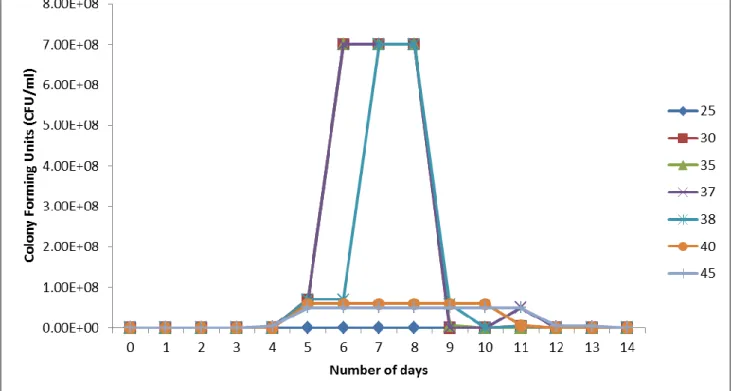
CONCLUSION
Determination of Polycyclic Aromatic Hydrocarbons [PAHs] in Processed Meat Products Using Gas Chromatography – Flame Ionization Detector. Degradation of Polycyclic Aromatic Hydrocarbons (2-7 rings) under microaerobic and very low-oxygen conditions by soil fungi.
